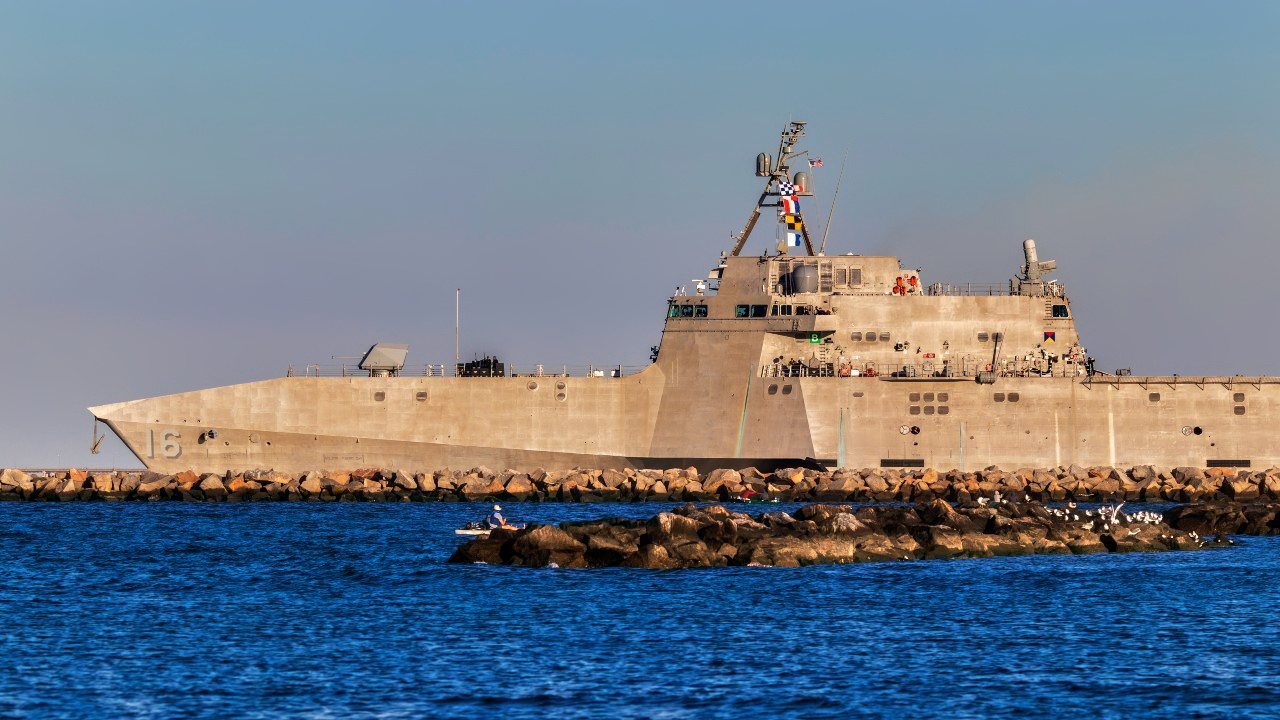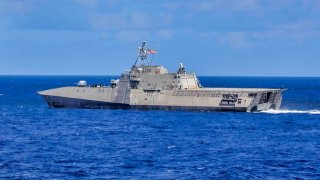The U.S. Navy's Failed Littoral Combat Ship Nightmare Is Almost 'Over'
The USS Pierre (LCS-38), the final Independence-class Littoral Combat Ship (LCS), has been launched, marking the end of this controversial program.
Summary and Key Points: The USS Pierre (LCS-38), the final Independence-class Littoral Combat Ship (LCS), has been launched, marking the end of this controversial program.

-Despite being touted for their speed and versatility in near-shore waters, the LCS fleet has faced criticism due to frequent breakdowns and the cancellation of planned mission modules.
-The U.S. Navy has already started retiring some of these ships ahead of schedule, and there are discussions about transferring them to allies for roles like drug interdiction or regional defense.
End of the Line for the Independence-Class Littoral Combat Ship – Final Vessel Launched
The United States Navy's Littoral Combat Ship (LCS) program has been seen as one of the sea service's biggest missteps since the end of the Cold War – perhaps only second to the Zumwalt-class destroyers. Both the LCS and the stealth destroyers were seen as failures for being the wrong ships at the wrong time, and while the U.S. Navy cut the Zumwalt-class program to just three ships – which made it a very costly mistake – the service has continued to accept delivery of brand new LCS vessels even as the oldest were retired years ahead of schedule.
This week, Mobile, Alabama-based Austal USA announced that it launched the future USS Pierre (LCS-38), the final vessel of the Independence-variant of the LCS program. Christened in May, LCS-38 is the nineteenth vessel of the class to be built by Austal and is on track to begin sea trials later this year.
"Meeting this ship milestone in such a safe and timely manner demonstrates how well our Austal USA launch team, transporter operators, and tug pilots have learned to work together over the last thirteen years, seamlessly executing this technical launch process," said Austal USA Vice President of New Construction, Dave Growden. "Our industry teams work methodically alongside our Navy partners to improve this innovative process with each launch evolution, guaranteeing the Navy a quality product delivered on time and budget."
After the future USS Pierre enters service, she will be homeported in San Diego.
LCS 38 is only the second U.S. Navy warship to be named for the South Dakota capital, while the first USS Pierre was a PC-class submarine chaser that was commissioned in 1943 during the Second World War, and decommissioned in 1958.
End of the Line for the LCS in Sight
The launch of the future USS Pierre comes just days after Lockheed Martin subsidiary Fincantieri Marinette Marine delivered the Freedom-variant USS Nantucket (LCS-27) to the United States Navy at its shipyard in Marinette, Wisconsin.
Two additional Freedom-class LCSs are now under construction – the future USS Beloit (LCS-29) and future USS Cleveland (LCS-31) – the final warships of the program. Both are expected to be handed over to the U.S. Navy by the end of the year. With their delivery, it will mark the end of the construction phase for the troubled LCS program – although it is unclear how long the fleet of LCSs will remain in service.
It was three years ago that the U.S. Navy began to retire the oldest of vessels of the respective variants – even as some of the ships have served in the fleet for less than half the expected twenty-five-year service life. To date, five have been decommissioned, while two more Independence-class variants are expected to be retired from service this year. In addition, the United States Navy has considered offering some of its LCS to allies and partners via the Pentagon's foreign military sales.
Littoral Combat Ship: The Little Crappy Ships That Can't
Though the warships were touted to emphasize speed and could operate in littoral or near-shore waters, such as those of the South China Sea, the LCS suffered from breakdowns while Congressional lawmakers cut the funding for the planned mission modules that were meant to provide flexible capabilities for the warships.
That has left the U.S. Navy with a lightly armed vessel that isn't ideally suited to a confrontation with a near-peer adversary such as China. As a result, there have been calls to transfer them to partner nations in South America, where the warships could be employed in a drug interdiction role, or to the Middle East where they could bolster the navies of regional allies.
It was only in April, that testing began on a Mine Countermeasure Mission Package (MCM MP) aboard the Independence-variant USS Canberra (LCS-30), which could finally give the LCS program purpose. The MCM package, made up of an integrated suite of unmanned maritime systems sensors, was developed to locate, identify, and destroy mines in littoral waters.
However, it would seem that module is too little and it comes too late for the warships that have earned the scorn of sailors and senior naval officials alike.
Author Experience and Expertise: Peter Suciu
Peter Suciu is a Michigan-based writer. He has contributed to more than four dozen magazines, newspapers, and websites with over 3,200 published pieces over a twenty-year career in journalism. He regularly writes about military hardware, firearms history, cybersecurity, politics, and international affairs. Peter is also a Contributing Writer for Forbes and Clearance Jobs. You can follow him on Twitter: @PeterSuciu. You can email the author: [email protected].
Image Credit: Creative Commons and/or Shutterstock.


